Bald Cypress (Taxodium distichum) Profile
Written by Iris
Aug 12 2021
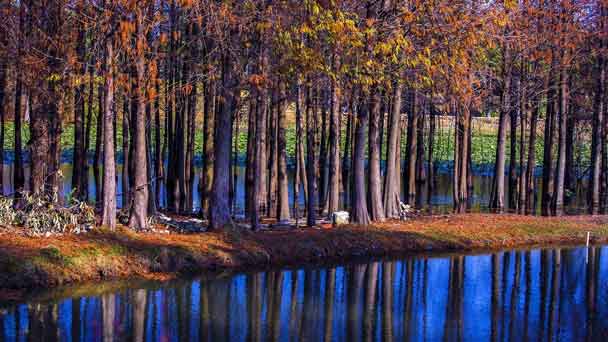
The bald cypress (Taxodium distichum) is a native American tree that grows naturally in the swamps of the southeastern United States. However, it is a highly adaptable species that grows well in a variety of soils and climates ranging from 5 to 10 in the USDA plant hardline zone. It is unique in that it is classified as a conifer, but differs from most of its plant Cousins. It is characterized by a soft texture, like fern leaves, good fall colors, and a medium growth rate.
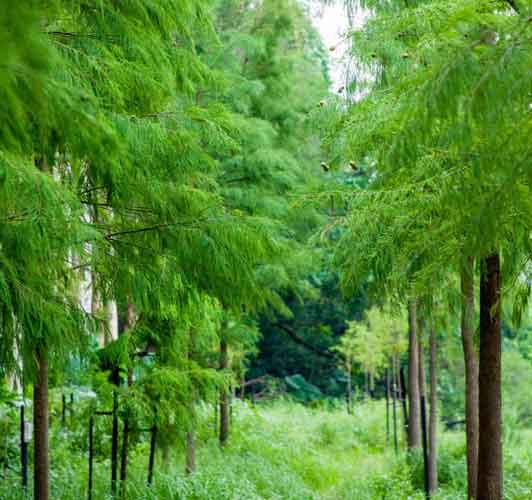
This tree has inspired much poetry and prose over the centuries due to Bald Cypress’s melancholy and mysterious appearance. Longfellow refers to Bald Cypress's "towering and tenebrous boughs" that "waved like banners that hang on the walls of ancient cathedrals" in his 1847 poem, Evangeline. Naturalist John Muir in his book Thousand-Mile Walk refers to "the dark, mysterious cypress woods which cover everything" and states that "night is coming on and I am filled with indescribable loneliness." Bald Cypress is the state tree of Louisiana.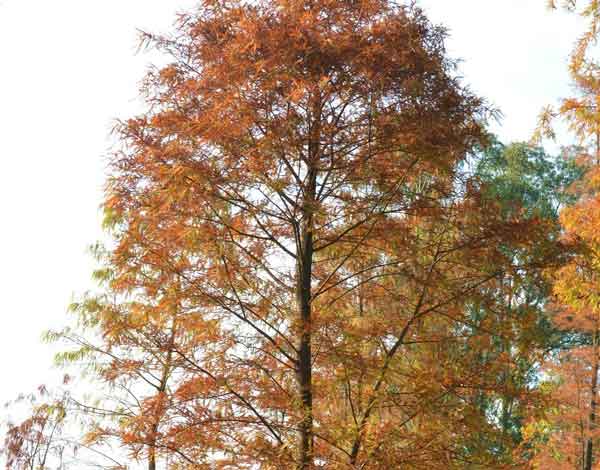
The native region of the Bald cypress are the swamps and floodplains in temperate to subtropical south eastern North America. The deciduous conifer has adapted itself perfectly to life in the swamps and water: Bald Cypress forms breathing roots, also know as cypress knees, which protrude from the water around the trunk. Inside, they are filled with a roughly structured tissue and have the task of transporting oxygen to the roots.
In Europe, the Bald cypress is already relatively widespread as an ornamental tree - Bald Cypress was introduced around 1640 by John Tradescant the younger, an English gardener and botanist. When the trend towards English landscape gardening emerged in the 18th century, and was adapted across Europe, the bald cypress spread rapidly. Groups of Bald cypress can still be admired today in the artificial lakes of many large landscape parks. The trees can reach very advanced ages - there are specimens known to be over 700 years old in their native locations in the USA.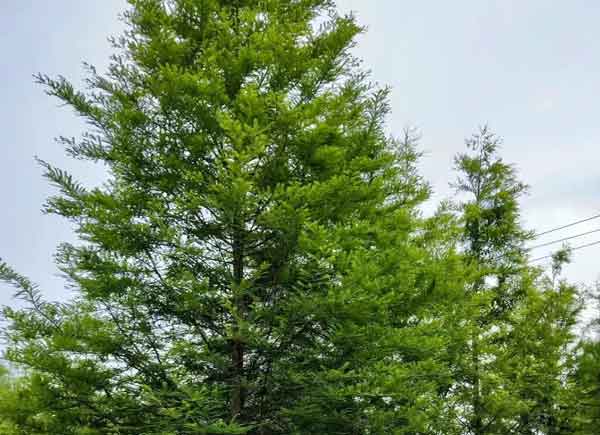
The ideal potting mix for bald cypress seed germination is a wet mixture of equal parts of coarse sand and peat moss. After the 90-day stratification period, remove the seed from the bag and push it 1 inch into the soil and ensure that it's covered. The bald cypress seed needs light and heat to germinate and the best way to provide these conditions is by setting the pot on a heat mat, set to 70 degrees Fahrenheit, near a window that gets indirect sun. Continue to saturate the planting mix with water so it remains wet while the seed germinates, which should happen within three to four weeks. Germination is erratic, so don't give up hope if you reach the four-week mark and there's no sign of a sprout. It may take as long as three months.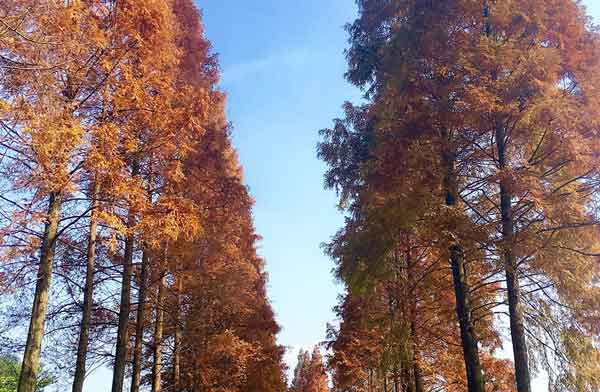
Bald cypress is relatively maintenance-free and requires pruning only to remove dead wood and unwanted lower branches which persist on the tree.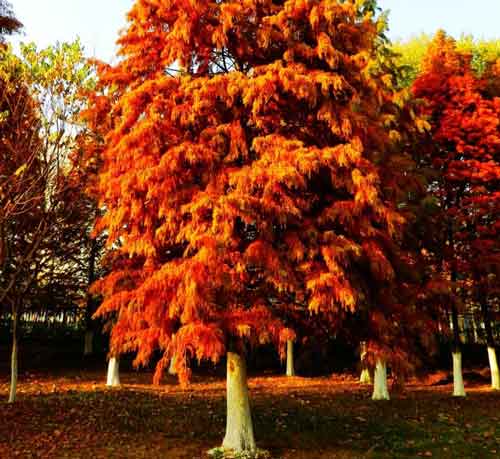
Bald Cypress‘Falling Waters’: This weeping bald-cypress will only grow as high as Bald Cypress is staked. Bald Cypress can be espaliered against walls or draped over walls to allow its branches to cascade; 20 feet high and wide at maturity. Needles turn bronze in the fall.
Bald Cypress Shawnee Brave (‘Mickelson’): Strong narrow pyramidal to columnar form with a dense crown; 50 to 75 feet high and 15 to 20 feet wide. The parent is 75 feet high and 18 feet wide. Needles turn orangish-brown in the fall. Introduced by Earl Cully of Heritage® Trees, Inc. Jacksonville, IL.
Bald Cypress‘Pendens’: Weeping pyramidal form has nearly horizontal branches with drooping or nodding tips.
Bald Cypress‘Peve Minaret’: Although a dwarf cultivar with closely spaced dark green needles, Bald Cypress can grow to a height and width of 20 feet and 8 to10 feet, respectively. This cultivar tolerates selective pruning that allows it to be “sculpted” into a variety of shapes and purposes. Excellent use in the Moore Farms Botanic Garden in Lake City, SC.
To create a romantic garden setting in locations with average moisture, consider Henry Lauder's walking stick for its twisting branches, common serviceberry for its delicate white flowers, and various ornamental grasses that soften the landscape.
Bald Cypress (Taxodium distichum) PictureBald Cypress (Taxodium distichum) InfoBald Cypress (Taxodium distichum) HistoryEcological Habits of Bald Cypress (Taxodium distichum)Bald Cypress (Taxodium distichum) Distribution AreaHow to Grow and Care for Bald Cypress (Taxodium distichum)Uses of Bald Cypress (Taxodium distichum)Varieties of Bald Cypress (Taxodium distichum)
Bald Cypress (Taxodium distichum) Picture

Bald Cypress (Taxodium distichum) Info
| Botanical Name | Taxodium distichum |
| Common Name | Bald Cypress |
| Plant Type | Deciduous Conifer |
| Mature Size | 50-70 ft. tall, 20-30 ft. wide |
| Sun Exposure | Full sun |
| Soil Type | Average, medium to wet, but adaptable |
| Soil pH | Prefers acidic, but can be adaptable |
| Bloom Time | Non-flowering |
Bald Cypress (Taxodium distichum) History
Baldcypress trees are native from Maryland along the eastern coast to Texas and as far west as the Mississippi valley. The first scientific reference to the species was made in 1640. The origin of the common name, however, seems to have been lost to time. No one is sure why Bald Cypress is called “bald” (though many guesses have been made).This tree has inspired much poetry and prose over the centuries due to Bald Cypress’s melancholy and mysterious appearance. Longfellow refers to Bald Cypress's "towering and tenebrous boughs" that "waved like banners that hang on the walls of ancient cathedrals" in his 1847 poem, Evangeline. Naturalist John Muir in his book Thousand-Mile Walk refers to "the dark, mysterious cypress woods which cover everything" and states that "night is coming on and I am filled with indescribable loneliness." Bald Cypress is the state tree of Louisiana.

Ecological Habits of Bald Cypress (Taxodium distichum)
In the wild, in U.S. Department of Agriculture plant hardiness zones 4 through 9, the bald cypress tree's cones turn from green to brown in fall. By winter, they will crack open, dropping the seeds into the mud or water where, if not eaten by wildlife, they remain dormant. Winter and spring flood waters pick up the bald cypress seeds and disburse them. They will not germinate under water so they remain dormant until the flood waters recede and the soil warms. The ideal germination bed is saturated with water, but not under water, for a period of one to three months.Bald Cypress (Taxodium distichum) Distribution Area
The Bald cypress (Taxodium distichum), also known as the swamp cypress, belongs to the Cupressaceae family. Bald Cypress is closely related to the dawn redwood (Metasequoia glyptostroboides) and also looks very similar to this tree.The native region of the Bald cypress are the swamps and floodplains in temperate to subtropical south eastern North America. The deciduous conifer has adapted itself perfectly to life in the swamps and water: Bald Cypress forms breathing roots, also know as cypress knees, which protrude from the water around the trunk. Inside, they are filled with a roughly structured tissue and have the task of transporting oxygen to the roots.
In Europe, the Bald cypress is already relatively widespread as an ornamental tree - Bald Cypress was introduced around 1640 by John Tradescant the younger, an English gardener and botanist. When the trend towards English landscape gardening emerged in the 18th century, and was adapted across Europe, the bald cypress spread rapidly. Groups of Bald cypress can still be admired today in the artificial lakes of many large landscape parks. The trees can reach very advanced ages - there are specimens known to be over 700 years old in their native locations in the USA.

How to Grow and Care for Bald Cypress (Taxodium distichum)
How to Grow Bald Cypress (Taxodium distichum)
- With Seeds
The ideal potting mix for bald cypress seed germination is a wet mixture of equal parts of coarse sand and peat moss. After the 90-day stratification period, remove the seed from the bag and push it 1 inch into the soil and ensure that it's covered. The bald cypress seed needs light and heat to germinate and the best way to provide these conditions is by setting the pot on a heat mat, set to 70 degrees Fahrenheit, near a window that gets indirect sun. Continue to saturate the planting mix with water so it remains wet while the seed germinates, which should happen within three to four weeks. Germination is erratic, so don't give up hope if you reach the four-week mark and there's no sign of a sprout. It may take as long as three months.
- With Grafting
How to Care for Bald Cypress (Taxodium distichum)
- Light
- Soil
- Water
- Temperature and Humidity
- Fertilizer
- Pruning

Uses of Bald Cypress (Taxodium distichum)
Forest Riparian Buffers
Bald Cypress's high flood tolerance, extensive root system, moderate shade tolerance and long life, makes Baldcypress a good candidate for use in forest riparian buffers.Wildlife Use
This tree provides resting and nesting cover for many species of wildlife.Landscape Use
Bald cypress and its cultivars make a fine stand-alone specimen or accent planting. They can be clustered together to create a grove or copse, planted near water features or along shorelines, planted as deciduous hedges or screens between properties, or in border plantings along driveways. Expect light, dappled shade from Bald Cypress's delicate, feathery foliage.Bald cypress is relatively maintenance-free and requires pruning only to remove dead wood and unwanted lower branches which persist on the tree.

Varieties of Bald Cypress (Taxodium distichum)
Bald Cypress‘Cascade Falls’: This weeping bald-cypress has a serpentine growth habit that requires staking early in its development until it develops a central leader and upright-growing branches that no longer require support.Bald Cypress‘Falling Waters’: This weeping bald-cypress will only grow as high as Bald Cypress is staked. Bald Cypress can be espaliered against walls or draped over walls to allow its branches to cascade; 20 feet high and wide at maturity. Needles turn bronze in the fall.
Bald Cypress Shawnee Brave (‘Mickelson’): Strong narrow pyramidal to columnar form with a dense crown; 50 to 75 feet high and 15 to 20 feet wide. The parent is 75 feet high and 18 feet wide. Needles turn orangish-brown in the fall. Introduced by Earl Cully of Heritage® Trees, Inc. Jacksonville, IL.
Bald Cypress‘Pendens’: Weeping pyramidal form has nearly horizontal branches with drooping or nodding tips.
Bald Cypress‘Peve Minaret’: Although a dwarf cultivar with closely spaced dark green needles, Bald Cypress can grow to a height and width of 20 feet and 8 to10 feet, respectively. This cultivar tolerates selective pruning that allows it to be “sculpted” into a variety of shapes and purposes. Excellent use in the Moore Farms Botanic Garden in Lake City, SC.
Bald Cypress (Taxodium distichum) Companion Plants
In very large spaces with moist soil, use baldcypress to frame and compliment weeping willow trees. Other plants that can tolerate wet soils include Virginia sweetspire, swamp milkweed, buttonbush, common winterberry, rosemallow, and common ninebark.To create a romantic garden setting in locations with average moisture, consider Henry Lauder's walking stick for its twisting branches, common serviceberry for its delicate white flowers, and various ornamental grasses that soften the landscape.
Latest Updated
- Benefits of Bugleweed - 7 Science-backed Health Benefits
- Bugleweed Dangers & Side Effects - Is It Poisonous?
- How to Plant Evergreen Trees - What You Should Know
- When to Plant Evergreens - Grow Guide for Evergreen Trees
- 12 Wonderful Evergreen Shrubs for Your Garden
- 12 Popular Evergreen Plants with Pictures for Beginners
- When And How To Prune A Lilac Bush Like a Pro
- How to Grow & Care for Lilac Vine (Hardenbergia Violacea)
- Japanese Lilac Tree (Syringa Reticulata) Care & Propagation Guide
- Shumard Oak Pros and Cons - What to Know
Popular Articles
- Winter maintenance of Antirrhinum Majus
- How to Grow Terminalia Mantaly Tree
- How to Grow and Care for Crossostephium Chinense
- How to grow Antirrhinum Majus in spring
- Peristeria Elata (Dove Orchid) Profile: Info & Care Guide
- Underwatered Snake Plant (Sansevieria Trifasciata) - Signs And How To Fix
- How to Care for Brazilian Jasmine Plant (Mandevilla Sanderi)
- How to Grow & Care for Graptopetalum Purple Delight in Summer
- Rosa Chinensis (China Rose): Plant Growing & Care Tips
- How to Care for Baby Sun Rose (Aptenia Cordifolia)